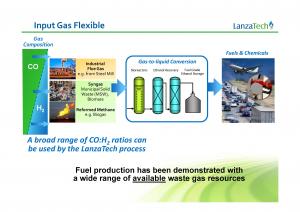

2011 Spring Meeting
As the world faces increasing energy challenges, one of the holy grails is a way to use waste carbon gasses to create new fuels or other high-value products. The ability to capture CO/CO2 to make a combustible fuel offers the possibility of a low/no-CO2 fuel. LanzaTech is currently piloting a CO/CO2 capture process, using a proprietary microbe that extracts carbon gasses from the air, to make fuel ethanol, using the basic oxygen furnace (BOF) gas from a steel mill in China. Roughly 30% of the carbon is converted into ethanol.

The Process
The waste gasses need to contain at least 15-20% carbon to avoid wasted (inert) capacity and the cost of unnecessarily oversized equipment. The waste gas is filtered then compressed into a storage/feed tank system. The fermentation takes place in a proprietary gas/liquid reactor system (pilot plant size of 500 gal) with controlled waste gas sparging. A particularly interesting aspect of the process is that the waste gas provides both the energy for growth (in the form of CO and/or H2) and the ethanol feedstock (the CO and CO2).
The fermentation process produces ethanol primarily. However, 7-10 mole % of 2,3-butanediol (BDO) is also produced. BDO is a potential precursor to other value-added (non-fuel) products, and in some feedstock situations, may be the preferred result of the fermentation. The ultimate purification and dehydration of the ethanol will follow standard ethanol product plant technologies, although proprietary processes are currently under consideration.
Variables
The carbon-to-hydrogen ratio of the waste gas can vary, with hydrogen being the preferred energy supply. However the microbe can use carbon to create the necessary hydrogen in situ if the feed gas is defficient, at the cost of shunting that carbon away from the alcohol production pathway.
Feedstock gasses currently piloted come from a particular process unit of the steel mill. However, based upon the nature of the wastes, petcoke and vacuum bottoms with pre-gassification steps are potential feedstocks, and waste biomass and municipal solid wastes are also potential candidates.
The bugs seem particularly robust to the presence of contaminants like H2S. Currently, the process is run in a continuous mode, with continuous removal of micro-organisms to maintain the desired average cell life.

Future Plans
The pilot plant is currently operating as expected. The next phase is to construct a "demonstration" plant capable of producing 100,000 gal/year. It is estimated that the large steel mill that LanzaTech has been working with could produce, full scale, over 50,000,000 gal/year of ethanol.
For additional information, visit LanzaTech's web site, or contact Dr. Mike Schultz.


